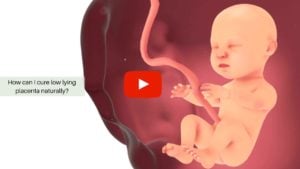The placenta serves a very important role during pregnancy, as it helps in the exchange of gases (oxygen and carbon dioxide) and nutrients between the mother and the baby.
Dr. Anita Sabherwal Anand, Obstetrician-Gynecologist with over 22 years of experience explains what you should keep in mind about a low lying placenta at 12 through 20 weeks, precautions, sleeping positions and more!
Watch the video below or read the transcription to learn all about how to treat low lying placenta naturally.
Where is the placenta located?
Normally the placenta is located on the roof of the uterus, also called the fundus of the uterus, or a little by the side of the baby.
In some cases, especially in the early ultrasound scans, we may see that the placenta may be lying below the baby, which covers the mouth of the uterus (cervix) or by the side of the baby.
In early scans, like in 12 week and 20 week scans, low lying placentas are quite common. However, as the uterus grows along with the baby, the placenta tend to move upwards. So if anyone has a low lying placenta, that is documented on a 12 week, 16 week or a 20 week scan, a repeat scan is always done between 28-30 weeks to confirm whether this placenta is likely to remain low or will migrate up.
In more than 90% of the cases, we will see in the 28 or 30 week scan that the placenta would be away from the mouth of the uterus, that it would have gone up, that it is no longer placenta previa.
In some cases where it remains placenta previa or it remains below the level of the baby or it covers the mouth of the uterus, then there is a risk of bleeding as the pregnancy advances.
As one enters the 9th month, the risk of bleeding increases. The bleeding is usually painless and without a reason.
How to Treat Low Lying Placenta Naturally
There are a lot of myths surrounding the treatment of low lying placenta.
However, one needs to understand that because it is a natural phenomenon, there are no food items, no sleeping positions and no method by which one can cure placenta previa.
Are there any precautions to take for low lying placenta?
Some people are advised total bed rest, some people are advised that they should not go for a walk and some people are advised they should not cook. But most often placenta previa bleeding happens when you’re resting. It doesn’t happen when you’re working. It is a natural phenomenon.
It is always advised to consult your gynecologist before attempting any chores.
As the placenta gets stretched by the growing uterus and it is in the lower part, because if the placenta is in the upper part, it doesn’t get stretched, it just grows along with the uterus. But if it is in the lower part, it gets stretched as the uterus grows.
Mostly the low lying placentas in early ultrasound scans do rise up and normal deliveries can happen.
Very rarely, whenever there is a low lying placenta even after 32 weeks or 36 weeks, then a cesarean section is done. Placenta previa is an indication for a cesarean section and in these cases, truly cesarean sections are a life-saving surgery wherein the life of the mother and the baby is saved only because a cesarean section is done.
If you would like to consult one of our gynecologists, don’t hesitate to call us on +919871001458 to schedule a telemedicine video consultation or an in-person consultation at our hospital in South Delhi.
Liked this article? Follow us on Facebook, Twitter, YouTube and Instagram for more content!
You may also like:
- Posterior Placenta: 5 Myths (and Facts) You Need to Know
- How an Anomaly Scan Helps & Why You Need It
- 5 Easy Tips You Need to Know for a Normal Delivery



